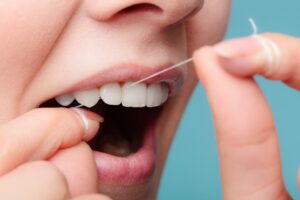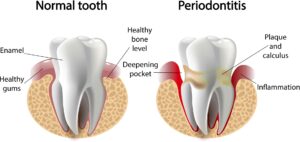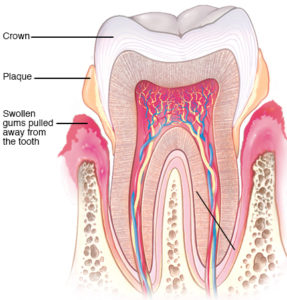Header logo
header top contact widget
Sore or swollen gums
Boost Immune System By Investing In Gum Health
Posted on Nov 17, 2022 by William J. Claiborne, DDS MS
There is no argument that the price of about everything has gone up and up over the past couple of years. The challenges that most individuals face at this time have been significant for some people but felt by about all.
Yet, there are still reasons to “spend less now so we’re not spending more later.” This is true with things such as auto maintenance, home repairs and taking good care of our health. A signifiant part of maintaining good overall health is having good oral health. The key, however, is to make the investment while the costs are still low, and avoid the big expenses later to pay for repairs and more extensive treatment.
I’d like to point out the need to bolster our immunity system, brought front-&-center during the pandemic, is actually supported by your oral health. Although the Covid virus continues to be a threat, the experience has made populations more aware of the benefits of vaccines and healthy habits such as hand-washing. Still, it is in our immune system that makes people more or less vulnerable.
By investing in having healthy gums, the immune system is actually supported more than is largely known. I’ll explain.
The bacteria in the mouth, or “oral cavity,” is intricately connected to your overall health; so much so that “bad” oral bacteria can disrupt the healthy balance in the digestive system. This bacteria comes from oral plaque, which is a cesspool of sorts formed from bacteria accumulation.
As a layer of biofilm, plaque coats teeth and gums. It is the sticky coating you feel in your mouth when you wake up, during which time the bacteria has had an opportunity to amass during sleep. Plaque, mot removed, becomes tartar. This hardened mass of oral bacteria continues to grow, doing damage in the mouth and far beyond.
Researchers have tracked oral bacteria as it enters the bloodstream. This occurs through weakened gum tissues, allowing the bacteria to travel throughout the body. Studies have shown that the bacteria are able to activate or worsen the development of a number of serious health problems.
These include heart disease, stroke, arthritis, diabetes, preterm babies, some cancers, erectile dysfunction and dementia. Research is currently being conducted to further the connections suspected between periodontitis to Alzheimer’s disease.
How does oral bacteria become destructive? Gingivitis is the initial stage of gum disease. Symptoms typically include gums that are tender in spots and some bleeding when you brush. These are warning signs that signal an immediate need for attention.
Periodontal (gum) disease and (often) its subsequent tooth loss are, simply put, products of bacterial overload in the mouth. The mouth is constantly being supplied with sustenance for these organisms. Bacteria are able to thrive through food that enters, especially sugars, and other bacteria-laden items put into the mouth.
The bacteria that cause cavities that feeds on sugar from the foods and drinks you consume. This weakens tooth enamel due as bacteria convert sugar into acids. As bacteria thrive, they are able to reproduce very rapidly.
When bacteria levels become more than the immune system can tackle, infection can set in. Accumulation of bacteria can evolve into gum disease, which is an inflammation that attacks teeth, oral tissues and the bone structures that support tooth roots.
Gum disease symptoms are those more prominent than gingivitis. These include sore gums that bleed when brushing, persistent bad breath, gums that pull away from the base around teeth, gums that darken in color.
As it worsens to the stage known as periodontitis, pus pockets may form on the gums at the base of some teeth. In advanced stages, gum disease causes teeth to loosen and eventually require removal.
The reason that 6-month dental check-ups and dental cleanings is to remove tartar buildup before damage can occur. Your hygienist and dentist can look for signs of gum disease so measures can be taken before the disease explodes into the need for more costly treatment to resolve the problem. Since gum disease is the nation’s leading cause of adult tooth loss, the associated expenses of replacing teeth can also be avoided by maintaining good oral health.
Prevention begins at home: Begin by twice daily brushing with a soft bristle tooth brush and use a fluoridated tooth paste. Brush for at least two minutes each time. Floss daily. Be sure not to pop the floss between teeth to avoid damaging tender gums. Move the floss in a back-&-forth motion between teeth to ease it down so you can scrape the sides of each tooth.
You can remove a tremendous amount of oral bacteria by using a tongue scrapper daily. Or, brush your tongue with your tooth brush at the end of each brushing. This helps to dislodge bacteria that is embedded in the grooves of the tongue.
Drink lots of water during the day. This will help keep saliva flow at ample levels. Saliva is designed to move oral bacteria from the mouth on a consistent basis. Oral dryness is the enemy. Avoid foods and beverages that are drying to oral tissues such as caffeine, alcohol, and spicy foods. Also, try to minimize the amount of sugar and carbohydrates you consume. These foods amplify the reproduction of oral bacteria.
Oral dryness gives bacteria a favorable environment for reproduction. The chemicals in cigarette smoke are very drying to oral tissues. If you smoke, consider using an oral rinse that replenishes moisture in the mouth. Some oral rinses are specifically designed for moisture.
Lowering treatment costs begins with early care: If you have delayed or avoided regular dental care, it is recommended that you begin by having a periodontal examination. A periodontist is a dental specialist who can determine your precise level of gum disease and the most appropriate treatment to restore good oral health. We can detect all stages of gum disease and provide comfortable, thorough treatment to restore your gums to a health state.
If you have lost teeth due to periodontal disease, a periodontist also specializes in the diagnosis and placement of dental implants. This ideal method to replace teeth provides a lifetime solution, making them an excellent investment.
Call 828-274-9440 if you have questions about your gums or if you are experiencing any symptoms associated with gum disease. Also, visit our web site to learn more about our sedation options (including “twilight sleep”) and advanced technology, which often reduces treatment time while enhancing comfort.
Visit: https://www.biltmoreperiodontics.com/
Challenges of Aging to Oral Health
Posted on Oct 28, 2022 by William J. Claiborne, DDS MS
Hopefully, the phrase “older and wiser” is one of truth. In all honesty, many adults “of a certain age” worry about being more forgetful, being less energetic and having less stamina. True or not, the aging process forges on for us all!
Aging, of course, comes with certain health challenges. However, these may bring seniors more determination to “age gracefully.” Today’s older adult seems to be more active and health-conscious than that of our ancestors. Aging adults now have greater knowledge of contributors to poor health. Most try to eat healthier, have periodic physicals and screenings, and include physical activity in daily regimens.
Over the years, all ages have had access to the findings of research reporting on how the health of the mouth plays a significant role in overall health. For example, the bacteria of periodontal (gum) disease are shown to potentially activate or worsen the development of a number of serious health problems.
For seniors, these health problems are especially challenging since a major one affected is that of the immune system. This is of high concern for seniors since their immune systems are typically operating at less-than-peak levels (often complicated by other health problems, such as arthritis or high blood pressure).
Over 70% of our immune response comes from the cells within the gut. The “good” bacteria in the gut is crucial to efficient digestion. Yet, it can be compromised due to the presence of gum disease bacteria.
We now know that the inflammatory nature of infectious oral bacteria can interfere with the healthy bacteria in the gut. This causes the gut (and well as other systems in the body) to function less efficiently. Research has correlated gum disease bacteria to heart disease, stroke, high blood pressure, diabetes, arthritis, some cancers, erectile dysfunction and even Alzheimer’s disease.
According to the Centers of Disease Control & Prevention (CDC), over 47% of American adults over age 30 have gum disease. It is estimated that 64% of adults ages 65 and older have either moderate or severe periodontitis.
Gum disease, an inflammatory disease, which can trigger inflammation elsewhere in the body. Studies have shown that by reducing the level of these bacteria, however, can improve other inflammation-based health conditions (such as arthritis, prostatitis, and psoriasis).
For instance, diabetes has a clear relationship with periodontal disease. Studies show that treating one condition positively impacts the other. By the same token, uncontrolled inflammation levels of one can worsen inflammation levels in the other.
Therefore, treating inflammation may help manage periodontal diseases and also help manage other chronic inflammatory conditions.
For seniors, oral dryness is one of the biggest influences in developing gum disease. Like the skin and joints, the body’s moisture and lubrication wanes with age. Although poor oral hygiene is a key factor when it comes to bacteria in the mouth, a dry mouth is a common contributor to bacterial growth.
In addition to aging, dry mouth is particularly challenging for seniors because it has many causes, including:
• A side effect of many medications (including prescription and OTC)
• Radiation therapy, especially for head and neck cancer
• Mouth-breathing, which may be due to nasal congestion or snoring
• Medical conditions, such as diabetes, Alzheimer’s disease, stroke and Sjogren’s syndrome
While important for all ages, older adults should be especially committed to their oral hygiene, including twice daily brushing and daily flossing. In addition, you can support saliva flow by:
• Drinking plenty of plain water throughout the day
• Avoiding (or limiting) caffeinated beverages, such as coffee, tea and colas
• Using an oral rinse designed to replenish moisture in the mouth (available OTC)
• Being aware of medications that have an oral dryness side effect (increase your water intake and use a daily rinse to replenish oral moisture)
• Taking steps if you snore or breath through the mouth during sleep (ask your physician for suggestions)
• During a cold or sinus condition that increases mouth-breathing, be especially committed to your oral hygiene routine at home (brushing and flossing) and increase water intake
• Following each alcoholic drink (including beer and wine) with gulps of water as these are very drying to oral tissues
• Taking all steps mentioned above if you smoke cigarettes, “chew”, or vape
 It is also important to know the signs and symptoms of periodontal (gum) disease. It begins with gingivitis, which causes the gums to become tender and swollen. When brushing, blood may be present in the sink when rinsing. Bad breath becomes persistent and the gums may turn red in color.
It is also important to know the signs and symptoms of periodontal (gum) disease. It begins with gingivitis, which causes the gums to become tender and swollen. When brushing, blood may be present in the sink when rinsing. Bad breath becomes persistent and the gums may turn red in color.
As an Asheville periodontist, I believe that the first step for adults who want to improve their oral health is by being informed patients. This generally leads to an individual who is committed to achieving and maintaining a healthy smile.
A good resource on maintaining good oral health is the web site of the American Academy of Periodontology: www.perio.org (go to Patient Resources). If you are experiencing any of the symptoms associated with gum disease as mentioned above, call our Asheville periodontal dental office at 828-274-9440. Gum disease will only worsen without treatment. (A referral is not necessary.)
Vape? Toke? Smoke? Give Added Focus To Oral Health.
Posted on Oct 10, 2022 by William J. Claiborne, DDS MS
Everyone has unique issues that can affect overall health. By knowing the specifics that are seemingly unrelated to your smile (such as certain medications, alcohol use, smoking and drug use), we can better tend to individual needs by helping to incorporate proactive measures into their oral care.
Rest assured that this information is confidential between you and your caregivers. It is not used to cast judgement. Your dental care team appreciates having this information and it’s certainly to your benefit when they do. It has been determined that marijuana use, even medical marijuana, can negatively affect your oral health.
Most dental offices are aware that the use of cannabis has become far more common over the years. According to data from the Centers For Disease Control & Prevention (CDC) from 2002 to 2014:
- Adults ages 35 – 44 showed a 43 percent increase in usage
- Adults ages 45 – 54 had a 48 percent increase
- Adults ages 55 – 64 had a 455 percent increase
- Adults over 65 had a 333 percent
https://drugabuse.com/whos-smoking-weed-these-days-you-asked-the-cdc-answered/
This increase is in contrast to the decrease in cigarette smokers, which may seem to be a positive switch for your oral health. However, all forms of smoking have a drying effect on oral tissues. This includes the use of e-cigarettes – known as vaping.
The CDC has found that tobacco cigarette smoking is at its lowest level ever recorded among U.S. adults. Still, about 1 in 5 adults in the U.S. reported using a tobacco product in 2017 (including smokeless products).
An estimated 14 percent of these adults who were every day or frequent cigarette smokers in 2017 was down by 67 percent since 1965. The CDC shares: “Another notable decline has been seen among young adults between 2016 – 2017: about 10 percent of young adults between 18 to 24 years smoked cigarettes in 2017, down from 13 percent in 2016.”
https://www.cdc.gov/media/releases/2018/p1108-cigarette-smoking-adults.html
Yet, marijuana use is not a healthy alternative for your smile. The risks to your oral health associated with cannabis use include:
- Compromised Saliva Flow: Saliva acts as a continual oral rinsing agent, moving bacteria and food particles that support bacteria growth out of the mouth. When saliva flow is insufficient, bacteria in the mouth are able to breed quickly. This becomes the source for bad breath, formation of cavities and periodontal (gum) disease.
- Increased Oral Health Problems: Oral bacteria feed on gum tissues, which enables them to thrive and accumulate quickly. The sticky film you feel on teeth at the end of the day is actually a coating of accumulated oral bacteria. When not removed daily through thorough brushing, this film can harden on tooth surfaces. Known as tartar, or calculus, this is a cement-hard mass of bacteria that eats into tooth enamel and destroys gum tissues.
- Risks For Serious Overall Health Problems: While your oral health undergoes a number of risks from oral bacteria overload, the potential for other serious health conditions has been found to originate with the infectious bacteria of gum disease. Because the bacteria of gum disease are able to enter the bloodstream through weakened tissues, research has shown inflammatory reactions can occur elsewhere in the body. This inflammation has been linked to heart disease, some cancers, stroke, diabetes, arthritis, preterm babies and more.

Marijuana may also cause additional risks that some people are unaware. For instance, the action of deeply inhaling marijuana smoke and holding it means the volume of intake is up to four times higher than with tobacco. This results in more poisonous carbon monoxide and tar entering the lungs.
Too, the tar in a marijuana joint contains many of the same carcinogens as tobacco smoke. These concentrations can be up to 50 percent higher in the smoke of a cannabis cigarette. For example, smoking just three joints a day can cause the same damage to the lungs as a pack of 20 cigarettes.
In order to maintain good oral health, for all individuals, a thorough at-home oral care regimen along with regular dental checkups and cleanings are important. However, for users of tobacco or cannabis, we advise having an examination by a periodontal specialist. A periodontist is a dentist who has received advanced training in the diagnosis and treatment of all stages of gum disease as well as in the placement of dental implants.
Because the symptoms of gum disease are not always obvious, a periodontist can ensure gum disease does not already exist. If it does, however, he or she can discuss treatment to restore your gums to good health and develop a program to help keep them healthy.
Also, be especially committed to your oral hygiene at home. This includes twice daily brushing, daily flossing and drinking plain water throughout the day. Another way to combat dry mouth is to use an oral rinse that is specifically formulated to replenish moisture. There are several OTC (over-the-counter), available in most drug stores.
Our goal is to help each patient achieve a healthy smile for life. For patients who wish to achieve this, we work with them according to individual needs. Through a customized treatment plan, your oral health can be a positive part of your overall health regardless of personal preferences. Call our Asheville periodontal dental office at 828-274-9440 to learn more or tap here to begin.
Does Obesity Lead To Gum Disease?
Posted on Sep 21, 2022 by William J. Claiborne, DDS MS
What are the two most common diseases in the U.S. today? Obesity and gum (periodontal) disease. Studies are now showing that these two conditions may be related.
However, tracking down “cause and effect” have not been achieved as yet. What is known, however, is that changes in body chemistry affect metabolism, which, causes inflammation, a common element they share. People who have periodontal disease are more susceptible to inflammation, which in turn makes them more susceptible to obesity.
One new study analyzed data from population subsets at one point in time in order to explore potential connection of pathways between obesity and gum disease. Researchers noted an increased risk to develop gum disease for those with higher body mass index (BMI), waist circumference and percentage of body fat.
Certainly, there are a number of risk factors for developing periodontal disease. These include:
• Smoking or chewing tobacco
• Poor oral hygiene and lack of dental care
• Consumption of sugar and other foods that increase oral acid levels
• Aging
• Being diabetic
• Many medications (including steroids, antidepressants, cancer therapy drugs, some calcium channel blockers and oral contraceptives)
• Improper fitting of dental appliances (dentures or partials)
• Pregnancy
Common signs and symptoms of gum disease are:
Gums that bleed easily
Red, swollen, tender gums
Persistent bad breath
Gums that pull away from the teeth (recede)
Changes in the way teeth fit together when biting
Changes in the fit of partial dentures
Permanent teeth that loosen or separate
Initially, gum disease begins with plaque accumulation. Plaque is the sticky film that coats teeth and gums that is usually most obvious when first waking in the morning. The film consists of bacteria, which can penetrate below the gum line. If not removed on a regular basis (preferably daily), plaque will harden into a bacterial mass known as tartar.
Plaque and tartar bacteria cause the gums to become inflamed. The tight grip around the base of teeth (which helps to seal out bacteria) will loosen. Thus, “pockets” of bacteria are able to form between the teeth and gums that become infected. As the disease worsens, these pockets deepen and gum tissues and the structures that support teeth are destroyed. Teeth can become loose and may have to be removed.
Gum disease is the nation’s leading cause of tooth loss. Research has also found links between the infectious bacteria of gum disease to other diseases affecting overall health. These include an increased risk of heart disease and stroke, diabetes, respiratory disease and preterm babies.
The prevalence of gum disease in the U.S. is at an alarming rate – affecting up to 50% of the adult population (ages 30-70) and 90% of adults over the age of 70. Yet, the obesity rates in America are at concerning rates as well.
According to the Centers for Disease Control & Prevention, U.S. obesity prevalence increased from 30.5% to 41.9% from 2000 – 2020. The highest percentage was among adults aged 40 to 59 years – 44.3%. (North Carolina ranks at 33.6%.) A healthy BMI is 18.5 – 24.9.
But, back to the gum disease-obesity connection…
A 2009 study showed that individuals with excess weight had twice the rate of periodontitis (advanced gum disease) and triple the rate for individuals with severe obesity. This was shown even after adjustments for other risk factors such as smoking, age and other medical conditions.
A leading factor lies in the fat cells, which were previously thought of as storage for energy. Now science has determined that fat cells produce a number of chemical signals and hormones, substances that lead to higher inflammation in the body. This, in turn, hampers the ability of immune system effectiveness. The inflammation add to the likelihood of periodontal disease.
As a periodontist in Asheville NC, I utilize some of the most advanced technology in the region to detect all stages of gum disease and restore the gums to a healthy state. This is true for all stages of gum disease, even the advanced level of periodontitis.
Depending on the level of disease, we can restore the tooth supporting structures (bone, gum tissue and ligaments) through thorough cleaning, tartar and plaque removal, and treating the deep pockets of infected tissue. Treatment is performed safely and comfortably, with oral and I.V. sedation (twilight sleep) available as needed.
When the severity of the disease requires surgical measures, we are fully skilled and equipped to restore oral health. We also assist restored patients with maintenance of proper oral hygiene for long-term success.
Understanding the relationship between obesity and risk factors that lead to periodontal disease is very important. If you have signs or symptoms of gum disease, please know that this condition will only worsen without treatment. The earlier your treatment, the less complex the treatment will be.
Call 828-274-9440 or visit: https://www.biltmoreperiodontics.com/services/periodontal-gum-treatment/
Sources:
https://www.colgate.com/en-us/oral-health/threats-to-dental-health/periodontal-disease-and-obesity
https://www.obesityaction.org/resources/obesity-and-periodontal-disease/
https://www.sciencedaily.com/releases/2019/12/191203082858.htm
Recent Posts
Categories
Archives
- September 2024
- August 2024
- July 2024
- June 2024
- May 2024
- April 2024
- March 2024
- February 2024
- January 2024
- December 2023
- November 2023
- October 2023
- September 2023
- August 2023
- July 2023
- June 2023
- May 2023
- April 2023
- March 2023
- February 2023
- January 2023
- December 2022
- November 2022
- October 2022
- September 2022
- August 2022
- July 2022
- June 2022
- May 2022
- April 2022
- March 2022
- February 2022
- January 2022
- December 2021
- November 2021
- October 2021
- September 2021
- August 2021
- July 2021
- June 2021
- May 2021
- April 2021
- March 2021
- February 2021
- January 2021
- December 2020
- November 2020
- October 2020
- September 2020
- August 2020
- July 2020
- June 2020
- May 2020
- April 2020
- March 2020
- February 2020
- January 2020
- December 2019
- November 2019
- October 2019
- September 2019
- August 2019
- July 2019
- June 2019
- May 2019
- April 2019
- March 2019
- February 2019
- January 2019
- December 2018
- November 2018
- October 2018
- September 2018
- August 2018
- July 2018
- June 2018
- May 2018
- April 2018
- March 2018
- February 2018
- January 2018
- December 2017
- November 2017
- October 2017
- September 2017
- August 2017
- July 2017
- June 2017
- May 2017
- April 2017
- March 2017
- February 2017
- January 2017
- December 2016
- November 2016
- October 2016
- September 2016
- August 2016
- July 2016
- June 2016
- May 2016
- April 2016
- March 2016
- February 2016
- January 2016
- December 2015
- November 2015
- October 2015
- September 2015
- August 2015
- July 2015
- June 2015
- May 2015
- April 2015
- March 2015
- February 2015
- January 2015
- December 2014
- November 2014
- October 2014
- September 2014
- August 2014
- July 2014
- June 2014
- May 2014
- April 2014
- March 2014
- February 2014
- January 2014
- December 2013
- November 2013
- October 2013
- September 2013
- August 2013
- July 2013
- June 2013
- May 2013
- April 2013
- March 2013
- February 2013
- January 2013
- December 2012
- November 2012
- October 2012
- September 2012
- August 2012
- July 2012
- June 2012


